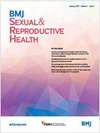Access to contraception and sexual and reproductive health information post-abortion: a systematic review of literature from low- and middle-income countries
Q Medicine
Journal of Family Planning and Reproductive Health Care
Pub Date : 2017-02-16
DOI:10.1136/jfprhc-2016-101469
引用次数: 21
Abstract
Aim This systematic literature review documented, analysed and critiqued the accessibility of contraception and sexual and reproductive health (SRH) information for women living in low- and middle-income countries who have undergone medical or surgical abortion. Methodology This review systematically collated relevant and recent empirical evidence regarding women's access to contraception and SRH information post-abortion within low- and middle-income countries. The PRISMA (Preferred Reporting Items for Systematic Reviews and Meta-Analyses) framework Guidelines, Flow Diagram and Checklist were utilised to undertake the review. The Ovid (MEDLINE), ProQuest, Science Direct, Web of Science, PUBMED and CINAHL databases were searched and studies that met edibility criteria were assessed for validity and analysis. A narrative synthesis of characteristics and results of the included studies is presented. Findings After detailed assessment of available and relevant literature, nine studies were selected for inclusion in the review. Studies highlighted barriers to contraception and SRH information including supply limitation, lack of comprehensive education and counselling, lack of skilled post-abortion care (PAC) providers and abortion stigma. Conclusions The review found that with access to a wide range of contraceptive methods combined with comprehensive SRH information and education, contraception uptake in women post-abortion does increase. The review also highlights the inconsistencies in clinic-reported ‘counselling’ and what this term actually involves within a PAC setting.获得避孕以及堕胎后的性健康和生殖健康信息:对中低收入国家文献的系统回顾
目的这篇系统的文献综述记录、分析和批评了生活在中低收入国家接受过药物或手术流产的妇女获得避孕药具以及性健康和生殖健康信息的情况。方法本综述系统地整理了有关中低收入国家妇女获得避孕药具和流产后性健康和生殖健康信息的相关和最新经验证据。PRISMA(系统评价和荟萃分析的首选报告项目)框架指南、流程图和检查表用于进行审查。检索Ovid(MEDLINE)、ProQuest、Science Direct、Web of Science、PUBMED和CINAHL数据库,并评估符合可食用性标准的研究的有效性和分析。对所包含研究的特点和结果进行了叙述性综合。研究结果在对现有和相关文献进行详细评估后,选择了9项研究纳入综述。研究强调了避孕和性健康和生殖健康信息的障碍,包括供应限制、缺乏全面的教育和咨询、缺乏熟练的堕胎后护理提供者以及堕胎耻辱。结论审查发现,随着获得广泛的避孕方法,再加上全面的性健康和生殖健康信息和教育,堕胎后妇女的避孕率确实有所提高。该审查还强调了诊所报告的“咨询”中的不一致之处,以及这个术语在PAC环境中实际涉及的内容。
本文章由计算机程序翻译,如有差异,请以英文原文为准。
求助全文
约1分钟内获得全文
求助全文
来源期刊

Journal of Family Planning and Reproductive Health Care
OBSTETRICS & GYNECOLOGY-
CiteScore
0.84
自引率
0.00%
发文量
0
审稿时长
>12 weeks
期刊介绍:
The trading of Professional, Managerial & Healthcare Publications Ltd has been transferred to its parent company, Keyways Publishing Ltd.
 求助内容:
求助内容: 应助结果提醒方式:
应助结果提醒方式:


